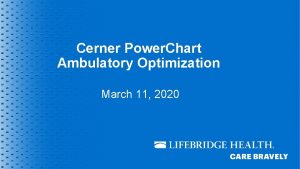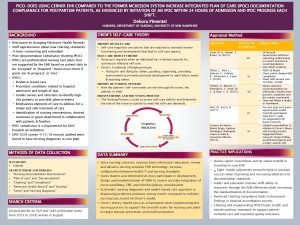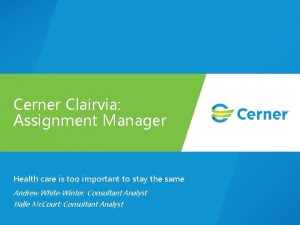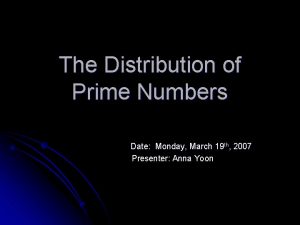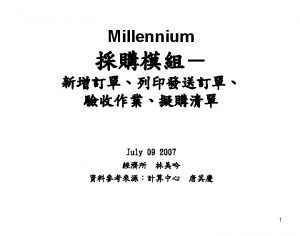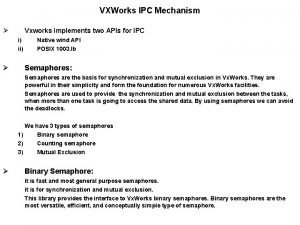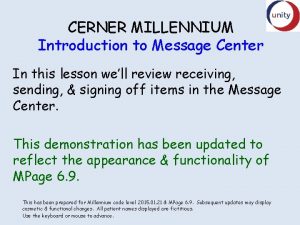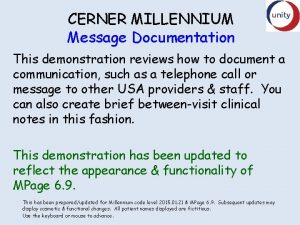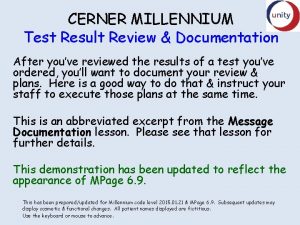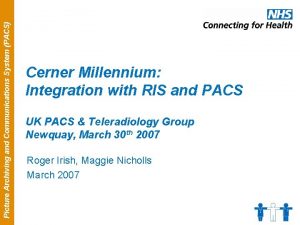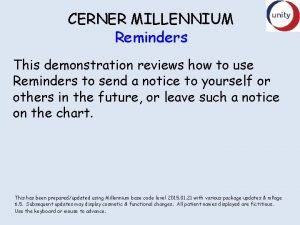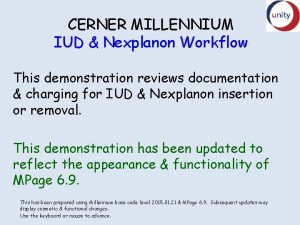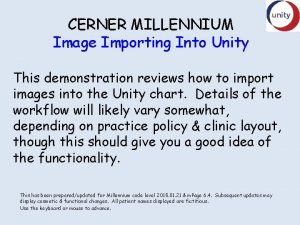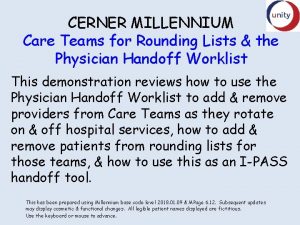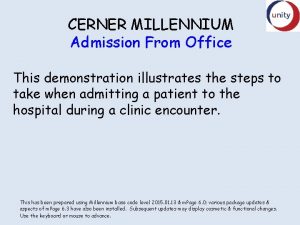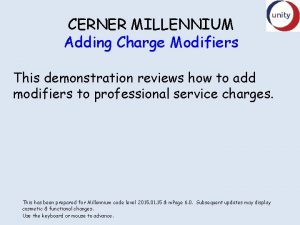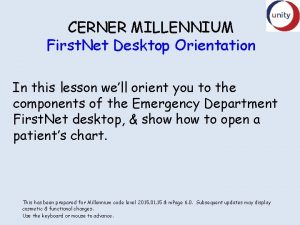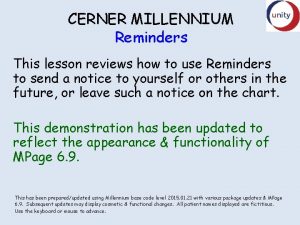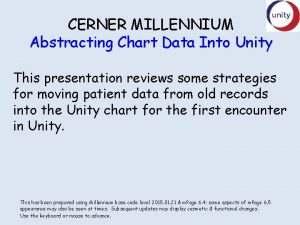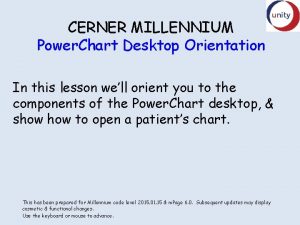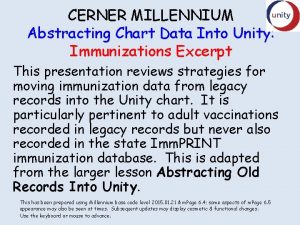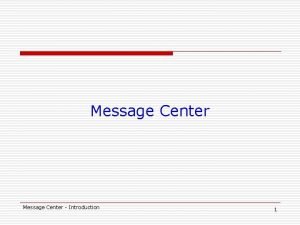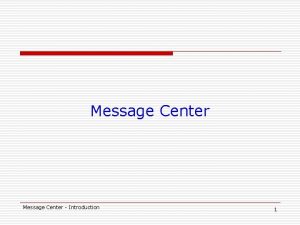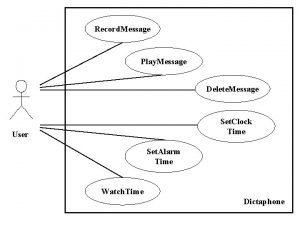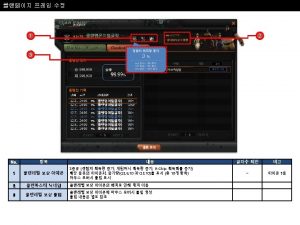CERNER MILLENNIUM Review of Message Center In this






















































- Slides: 54

CERNER MILLENNIUM Review of Message Center In this lesson we’ll review common activities you’ll perform in Message Center. This demonstration has been updated to reflect the appearance & functionality of MPage 6. 9. This has been prepared using Millennium base code level 2015. 01. 21 & MPage 6. 9. Subsequent updates may display cosmetic & functional changes. All patient names displayed are fictitious. Slides will advance automatically with narration. Use the left arrow to pause or go back to review; use the right arrow to resume play.

When you first log on, you’ll land on a Home screen that usually includes the Message Center on the left.

You can also open the Message Center directly by clicking the Message Center button.

There are three tabs in the Message Center. Inbox is where you’ll spend most of your time. (The Proxies & Pools tabs may not be used by everyone; we’ll touch on them a little later. )

Within the inbox are a number of folders that help organize your messages, similar to what you might have in an Email inbox. These folders may appear/hide/expand/contract as they’re populated with contents, so you may not always see them all.

When you click on one of these folders, you’ll see a list of messages in that folder to the right. The exact appearance, columns, & organization will change depending upon the type of message it is, e. g. a signoff request vs a test result. Clicking on a column heading will usually sort that column in ascending order; another click sorts it in descending order.

When you click on a message, the contents may preview below, depending upon the nature of the message.

When you click on a test result, the results will preview at the bottom. To sign off, double-click the message.

After reviewing the results, click Review, then OK & Close (or OK & Next to move on to the next item on the list).

You can also Refuse a result, e. g. , if it was sent to you in error. Select a Reason, Additional Forward Action Review, & add Comments.

If you know who to forward the item to, search for that person in the To field. If you don’t know who to send it to, type refusal & click the search binoculars.

You’ll see a Refusal recipient for each hospital, MCI, & the ambulatory clinics. Select the appropriate one, then click Add to move it to the right. When done, click OK.

When done, click OK & Close or OK & Next.

You may receive documents to Sign or Review, e. g. , letters, forms, or resident notes to sign off. When you select one, it will often preview below. To sign off, double-click the message.

If it’s a scanned form or outside medical note, look it over, then click Review followed by one of the OK & Close / OK & Next buttons.

If it’s a resident note that needs to be cosigned by an attending, begin by clicking the Modify button.

The note opens in a window where the attending can further review, edit, delete, or add parts to the note. When signing off a resident’s note, the attending will add one of the approved attestation lines via Auto. Text. These can be brought up by clicking under the Attending Attestation heading & typing +.

A list will appear. Double-click the desired option. The text will be added.

When done, click Sign/Submit in the lower right corner. Then click Sign again in the next window.

Providers may also receive orders for cosignature in the Message Center. These will usually be protocol-based standing orders or verbal/telephone orders. To begin, double-click the order.

The order opens in a new window where you can review details; the exact appearance will vary with the type of order. If acceptable, click Approve, then OK & Close (or OK & Next to move on to the next order on the list). You can also Refuse an order, & add Comments. A notation of your approval or refusal will be added to the chart.

Sometimes when you receive a result, document, etc. , you may not remember the patient well, or you may need some context to know how to respond to the message. One option is to click the Summary View button.

This opens the Summary tab for the patient, where you can review various aspects of the chart.

If you need to see even more detail, you can open the full chart from your inbox. Rightclick the message. Hover Open Patient Chart, then select an area of the chart you want to start with.

Review any aspect of the chart as needed.

Back in Message Center, you can also send Messages or Reminders to others or yourself. To send a message, click the Communicate dropdown arrow, then click Message. This would let you send a communication about any patient.

But here’s another nice thing to know. There’s also a Communicate button on the toolbar at the top. With a patient selected, you can send a message about this specific patient, without having to select the patient in the next step.

If you didn’t use the trick just mentioned, search for the patient to enter the name here. To search for the recipient, type at least part of the name, then click the binoculars button.

In the results list, double-click the desired recipient, then click OK. (You can select more than one recipient. )

You can include yourself as a recipient, CC others, change the subject line, & choose to Save to Chart. Then enter your message.

At the bottom, you have some standard entries you can check. You can also set a Due on date if that is pertinent. (Remind On doesn’t really do anything significant. ) When done, click Send, & it will go to the recipient’s inbox.

Sometimes it’ll be better to send a Reminder instead of a Message. Unlike messages, which are transmitted immediately, reminders can be set to show up at a specified time in the future when they’ll be most pertinent. You can send reminders to yourself or others. To begin, with the patient’s chart open, click the Communicate dropdown arrow, then Reminder.

As for messages, search for a recipient (potentially just yourself), modify Subject line, then type & format the communication as desired. If you want to send the reminder immediately, leave Show up set to 1 minute, then click Send.

But in this example it would be much more useful if the reminder appeared at a future date when it is immediately pertinent. Using any of the tools in the Show up section, adjust the date as desired. You can also specific the time if necessary. This could be particularly useful if you want the reminder to appear later today. When done, click Send.

When the show up date & time have arrived, the recipient will see the reminder appear in the Inbox. Double-click the reminder to view it.

After reviewing & acting upon the reminder, click Complete to remove it from your inbox.

Another thing you can do in Message Center is subscribe to certain types of messages. Examples might be the notes every time the patient is seen at the ED or admitted to the hospital, or a copy of all test results on the patient, regardless of who ordered them. With Message Center open, click Inbox, then Manage Preferences.

Go to the FYI Result Subscriptions tab. There are several subscriptions that have been created for various specialties & venues. But some that will be of interest to most providers are Adhoc Results FYI(Adhoc), Admitting Physician – Post Disch. Result, Attending Physician-Post Disch. Results, Consulting Physician-Post Disch. Results, & Primary Care-Discharge/Admission Doc. Select these, then click Assign.

These subscriptions give you the following: 1) Results for inpatient tests you order that come back after patient discharged from hospital. 2) Results that come back after patient discharged from hospital for any patient you consulted on as inpatient. 3) A copy of H&P, discharge summary, & ED notes any time patient is at the hospital, when you’re the patient’s PCP.

Adhoc Results FYI(Adhoc) gives you something else— all results that come back on a selected patient, regardless of who in the system ordered the test. To utilize this, you need to pick the desired patient(s). Go to Inbox, then click Manage Ad Hoc List.

Click Add Patient.

Search for your patient; double-click your selection.

You can choose to have the subscription for a defined period of time, or to run indefinitely. (You can always come back & change it later. ) After specifying the time frame, click Apply. You can then select more patients if desired. When done, click OK.

Now let’s look at the Proxies & Pools tabs you saw earlier. Pools allow a group of people to monitor a common message list. Some clinics may have pools of nurses or front office staff who can all work the same list of tasks. Other venues may not utilize this functionality.

Proxies allow you to designate people to cover your inbox for you. To set this up, click Manage.

Click Add.

Type your colleague’s name; if the match doesn’t immediately display, click the search binoculars.

Refine you search if necessary, & double-click the desired match.

The name displays. Click the down arrow to move it down into your list of proxies.

Next set the beginning & ending dates/times for the proxy to be in effect. You can decide what items you want your proxy to see. Pick & choose as desired, though often you’ll just want to click Grant All.

Click Accept & Next.

Your proxies are listed. If you click on one you can revise the details, or remove it. When done click OK.

If you’ve been granted someone’s proxy, you view those messages by going to the Proxies tab. You might be the proxy for more than one person. If so, select the one to view from this dropdown list. Select the proxied message & attend to it as you would your own messages.

While there are numerous variations on what you can see & do in Message Center, this should give you a pretty good grasp of general functionality.
 Cerner ipoc
Cerner ipoc Workforce cerner
Workforce cerner Workforce cerner
Workforce cerner Cssr-s risk assessment
Cssr-s risk assessment Cerner junefordbloomberg
Cerner junefordbloomberg Cerner hps
Cerner hps Cerner ambulatory organizer
Cerner ambulatory organizer Cerner icons
Cerner icons Cerner care compass
Cerner care compass Cerner smart templates
Cerner smart templates Kathleen fisher cerner
Kathleen fisher cerner Cerner ipoc
Cerner ipoc Clearvia reviews
Clearvia reviews Millennium geospatial
Millennium geospatial Third millennium
Third millennium Millennium prize problems
Millennium prize problems Millennium
Millennium Innopac millennium
Innopac millennium Draw a conclusion about the millennium development goals.
Draw a conclusion about the millennium development goals. Chapter 26 section 1 the 1990s and the new millennium
Chapter 26 section 1 the 1990s and the new millennium Poincare conjecture solver
Poincare conjecture solver Crystal ballroom millennium biltmore hotel
Crystal ballroom millennium biltmore hotel Millennium science complex
Millennium science complex Millennium 3 financial services
Millennium 3 financial services Millennium ecosystem assessment
Millennium ecosystem assessment Mood and tone difference
Mood and tone difference Millennium
Millennium Millennium
Millennium Millennium clock tower edinburgh
Millennium clock tower edinburgh Millennium planters
Millennium planters Millennium
Millennium Us digital millennium copyright act ethics
Us digital millennium copyright act ethics Thinking like a biotechnician
Thinking like a biotechnician Millennium goals 2000
Millennium goals 2000 Tacholink
Tacholink Millennium goals 2000
Millennium goals 2000 Millennium insurance
Millennium insurance Millennium assessment report
Millennium assessment report Sir gawain and the green knight medieval romance
Sir gawain and the green knight medieval romance Millennium goals 2000
Millennium goals 2000 Millennium ecosystem assessment
Millennium ecosystem assessment Städtereisen nodo district
Städtereisen nodo district Millennium scholars program
Millennium scholars program Chapter review motion part a vocabulary review answer key
Chapter review motion part a vocabulary review answer key Ap gov final review
Ap gov final review Nader amin-salehi
Nader amin-salehi What is inclusion and exclusion
What is inclusion and exclusion Narrative review vs systematic review
Narrative review vs systematic review Aida persuasive message
Aida persuasive message Date line inside address salutation message closing
Date line inside address salutation message closing Micah 6 8 the message
Micah 6 8 the message Welcome visitors images
Welcome visitors images Thoughtful thursday morning message
Thoughtful thursday morning message John 2 msg
John 2 msg Vxworks message queue
Vxworks message queue






